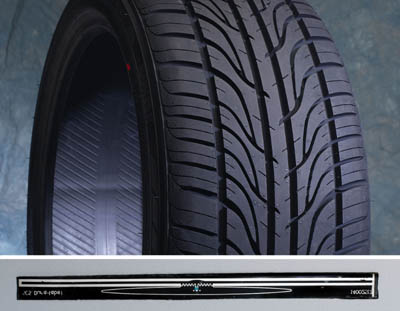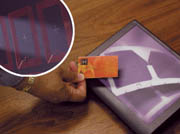Bar coding is a cost-effective and low-risk method of encoding information that helped start sophisticated supply-chain management. Radio frequency identification (RFID), on the other hand, enables users to collect and encode information for many items simultaneously by way of radio frequency as opposed to the optical systems used to read bar codes.
Both bar codes and RFID have a place in supply chain management/tracking. But when is one method more practical than the other? This article will examine the history, similarities and differences between bar codes and RFID.

A Good Place to Start
Bar codes have become much more refined over the past 25 years. The method of printing has changed drastically with more economical printing choices and computer-generated variable information printed (VIP) bar codes yielding higher printing definition for improved reading accuracy. Bar code symbols have also evolved, mainly through the need for more sophisticated printing and end-use demands. This demand has caused pressure-sensitive print media and adhesives to evolve as well.Though not as widely used, RFID is quickly becoming the preferred scanning solution for many markets. Radio frequency identification is a dynamic alternative thanks to increased data storage, ease of automation and tracking, higher throughput, and its ability to be written and rewritten.
A typical RFID system consists of three components: the reader with a transmitting antenna; the tag (transponder) that includes an RFID chip programmed with unique information; and the computer, which interfaces with the reader and has the ability to store information beyond memory storage on the RFID tag.
Decisions, Decisions
As you’re reading this, you may be asking yourself what method would work best for you. Several questions must be answered before you can reach that decision.
First, consider your purpose. If it’s identification, a bar code is ideal. But if you need additional information storage, enhanced read range, discrete positioning, monitoring (environmental factors) or improved security, you’ll need to move beyond the bar code. Some questions to consider in determining your tag’s capabilities include the following.
What RFID frequency is best for your application?
Unlike bar codes, RFID has very few standards. There are common frequency ranges, for example, but the reader power output and specific frequency may vary by country and manufacturer. In addition, systems within the frequency range may have their own chip set, protocol for memory storage, air protocol and antenna design.
What information do you want to store? Will you update by way of mainframe or tag only?
All are important questions when determining your system’s software and computer infrastructure. Radio frequency identification presents you with several options when selecting the contents and “maintenance” of your tag.
Where will the tag be applied to the object?
With non-contact, non-line of sight reading, the RFID position isn’t as crucial as previous tracking methods. However, while placement is no longer an issue, your substrate may become one. For example, low-energy surfaces such as polypropylene and polyethylene may require high-performance adhesives such as MACtac’s MACfilm IF-2090 Series. In addition to substrates, you’ll also need to consider the environment, especially one where your tag will encounter extreme temperatures. The MACfilm line features a high-temperature free film designed for these types of applications.
Does the tag require special protection from extreme conditions?
Radio frequency identification tags are robust in adverse environments (fog, snow, paint, dust). This is beneficial for tags that will be printed on and used as prime labels.
How much memory storage do I need on the chip?
Tags allow you to store at least 1KB of item-specific information (as opposed to SKU identification).
Should the chip be read or read-write?
Readers/interrogators have the ability to rewrite or add information to a tag more than 100,000 times. Data can be locked or encoded for additional data security.
What type of read range do I need?
RFID systems can be designed to read information 30 feet away and further.
Other factors that could influence your decision include the following.
• Infrastructure. Radio frequency identification is still building its infrastructure as the industry grows. There are continued technological developments in its hardware, software and consumables. The industry is also building the staffing to support the manufacture, installation and support of the RFID systems. However, the infrastructure is not present in the scale to support replacing bar codes with RFID.
• Cost. The RFID systems are inherently more expensive than bar codes. With volume and technological innovation will come cost reduction, and the costs continue to decline in all areas from tags and chips to readers and installation. There is considerable investment in all areas to drive the cost of RFID closer to bar code systems.

Reading the Future
Eventually, RFID will become as commonplace as bar codes. Tags are being used globally in the medical, transportation, airline, retail, distribution and logistics industries. Applications vary from tracking and authenticating ethical drugs to video rental to tracking patrons at amusement parks for security.MACtac is technology independent, meaning we can work with all common frequencies, hardware systems, chips and label media face stocks. Our core focus is the manufacture and converting of pressure-sensitive tags and labels coupled with RFID technology. To do this, we’re partnering with various technology providers for greater flexibility in discovering a solution for customers’ needs. Some examples of how our PSA capabilities allow us to offer a complete RFID solution include the following.
• Tires/windows (automotive market). By attaching a tag to tires, automotive manufacturers are able track tires with quick and easy access to the tire’s characteristics. If required, they can easily conduct thorough recalls without the risk of fraud. In addition, non-tamper window tags provide added security against theft.
• Luggage tracking. MACtac’s tags are produced in a system where they can be inserted into a secondary operation; in this case, luggage tags for security screening.
• Industrial laundry process. MACtac's durable yet flexible tags are able to withstand the harsh environment of industrial laundry equipment, allowing them to be used for the daily tracking of up to 400 laundered items in a bag in just seconds.
• Media rental. Attaching a tag to movies (VHS/DVD) provides customers with a self-checkout option, thus allowing employees more time for customer interface on the floor.

Bar Codes Beware?
Although its growth is modest in comparison to RFID, bar code systems will continue to grow.
As bar code systems continue to evolve, so will MACtac. Being a leading producer of variable information printing (VIP) pressure-sensitive products, the company continuously invests in new product technologies like its direct thermal alliance with Kanzaki and works to strengthen its close partnerships with VIP printer OEMs.